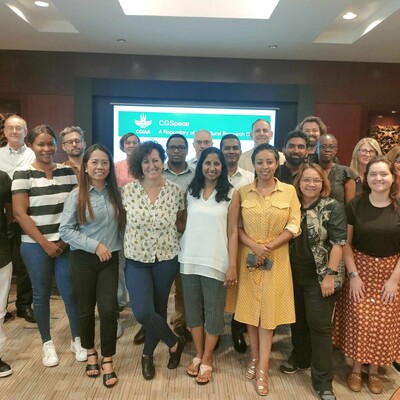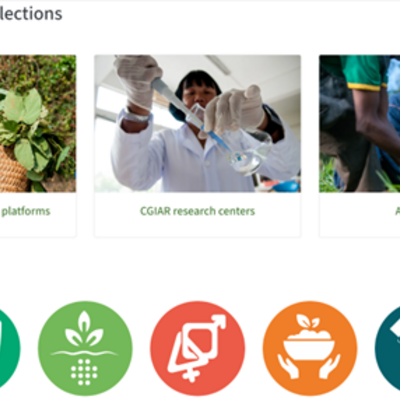
Overcoming the dangers of PowerPoint recitals
In the ILRI communications and knowledge management (CKM) team, we love supporting events. Through our support, we hope the events illustrate all that the CKM team stands for: awareness and advocacy, curation and publishing and engagement and collaboration. As much as possible.
We have been invited to facilitate events where everything about the event had already been agreed, committed and designed. Preconceived design plans that entail more than 30 PowerPoint (PPT) presentations over two days is not ideal nor recommended for any facilitation team to step into. Facilitation is not about chairing an event, it is about helping design and plan the event’s agenda to ensure that everyone does their best thinking.
One such scenario happened recently around a conference on Policies for competitive smallholder livestock production (Gaborone, Botswana, 4-6 March 2015). The organizers invited us to support it – which was great – but had already made all preparations for the event before engaging with us. With a line up of 34 presentations over the two days we had an uphill task adding full value to this event.
Here is how we turned what was going to be at PowerPoint recital into a festival of powerful points.
Know the strengths and weaknesses of your tools
Firstly, PowerPoint is not the enemy. There are wonderful examples of PowerPoint presentations. But the use and abuse of PowerPoint can be a real problem.
The basic problems with having a PPT recital are:
- PowerPoint should only be an aid but it has generally become the central element of a presentation in the minds of many. Why? To what extent do people actually listen to the speaker when they have slide after slide to read? Where is the human storytelling dimension?
- Not everyone is a good public speaker and reading slides word for word is not helpful. Speakers need to know the content they are presenting. Practice in front a mirror if need be, preparation is paramount. A well-versed presenter is memorable, a lengthy text-filled presentations is not.
- Not everyone prepares good presentations. Mixing it up with images, graphs and even video can captivate the audience. Use these as alternatives to text so that audience need to pay attention to the presenter to understand them. Text-filled slides make it difficult for the audience to read and listen at the same time.
- Once a recital starts, subconsciously people enter a ‘PPT mode’ whereby they passively consume information and easily start drifting into other thoughts. Reigniting their brains is then quite hard.
- A succession of PPTs makes it probable that each speaker goes over the set time, reducing time for interaction, and this negative spiral likely accelerates as the agenda unfolds – sometimes drastically cutting down on group discussion time.
- Bringing people together to go through a lot of presentations is a missed opportunity: presentations can be shared online. The conversation, decision-making and communion of minds, on the other hand, cannot (at least much less easily). Logorrhea is always a missed opportunity
- Most fundamentally: no one has the capacity to absorb 30+ presentations in two days. There is even a notion that the brain switches off after 10 minutes. Information needs to be digested slowly and with the inputs of the audience (through conversations) in order to be owned and used for change.
Now that the premises are set, what did we do to control damage in our event?
Take some precautions…
Some of it boils down to the basics of facilitation:
- Insist that each speaker takes no longer than 7 minutes for their presentations. This may not be suitable for a scientific conference but it is hugely advisable for policy-focused events. And that’s where the powerful points emerge: everyone skips the lengthy research method details to clarify important highlights and policy implications. And if people take a bit more than 7 minutes your schedule is still rather safe.
- Brief the speakers about your instructions beforehand. Let them know the rationale of your instructions regarding the presentation length, style etc. ahead of time so they can rehearse and feel comfortable with the presentation, given the constraints.
- Prepare your visual aids to manage time effectively. We made use of a ‘2-minute’ and a ‘stop’ sign to visually remind speakers about the time they had and whether they should not proceed with the most important part of their presentation. This helped them get their argument right and helped us go through the program with overall a rather tight time management approach.
- Expand the coffee breaks – people need time to refresh themselves, chat, tend to their emails etc. We expanded breaks from 15 to 30 minute.
- Carve as much time out as possible for group interactions. After a series of presentations, when groups convene, they allow participants to a) digest the information and b) draw on their own experience to build a collective picture that is stronger than the collection of the individual perspectives. It is at that moment that the magic can really happen in an event. We made sure we pushed the time to make this a reality. It was not always easy, and we always ended up with too little time (20 to 30 minutes). And at the end of the event, we also cushioned some time to have some more collective reflection.
And take some risks…
And in the type of scenarios we faced, some of it relates to gambles you take, that either fly or not. Here are some we tried:
- Remove or adapt the role of chair(wo)men. We asked our chairs – who very graciously played the game – to only introduce the session and ensure there was a process in place to synthesize their specific theme/session. We reduced their protocol and amplified their contribution to raise awareness about the importance of each theme.
- Step away from the tradition of plenary questions and answers (Q&A). What we do a lot these days is to have a batch of presentations for about 20-30 minutes and then put the speakers at all corners of the room to do the Q&A session in parallel. This way they have more time to answer more questions. Speakers and the audience are happy. And you can even ask the presenters to share very briefly the key points they discussed in their interaction with participants.
- Let the speakers feedback on their Q&A time and paraphrase them. Paraphrasing (reformulating one’s points) can be a powerful way to clarify thoughts and bring everyone on the same page.
- Invite participants to not use PowerPoint. In the AgriFood chain workshop from September 2013 (and to a lesser extent in the Dairy seminar organized in September 2014), we convinced participants to share their information in other ways. In this Botswana event, we allowed participants to choose that option and quite a few took a chance, which resulted in some really interesting and successful stories.
- Empower and train participants to play a more active role in writing flipcharts and reporting back in plenary.
Looking back and learning forward
We spent every evening and at the end of the event, to review what had happened (or what should happen the next day). This ‘after action review (AAR)’ ritual is an essential feature of event organization and facilitation. Here are some of our reflections about the event.
The competitive policies could have featured more interaction for participants to have more time to learn from each other, know each other and work the network a bit – which is an essential part of any event. While each little process detail we brought did not account for much of its own, the collection of small changes led to a much more vivid overall picture.
For facilitators, this event was an opportunity to stretch our imagination in a rigid environment (to start with) and to come up with alternative ways of organizing PowerPoint-heavy conferences. We also found a few other tricks and tips to improve the process flow of the event.
For the organizers who had designed the initial steps, this was also a learning journey to think about how an event can be made even more effective. The whole event was a learning experience for both the organizers and facilitation team with more appreciation for what facilitating and supporting an event can really mean.
We thank the organizers for giving us the opportunity to learn together and generating a fresher take on the ubiquitous PowerPoint recital.
If you want some support for your events (design, facilitation, documentation etc.) please contact Ewen Le Borgne or Peter Ballantyne. For Nairobi-based events, please contact Muthoni Njiru and for Addis Ababa-based events you can also contact Tsehay Gashaw.
Find out more about (how we support) planning your events here.
(This post was written by Ewen Le Borgne and Muthoni Njiru)




















